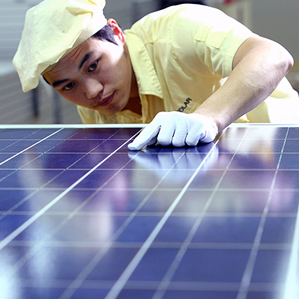Solar Downturn Casts a Shadow Over Innovation
Suntech Power, the large Chinese solar panel maker that filed for bankruptcy last month, isn’t the only solar company teetering on the edge. Almost all of the world’s largest solar panel makers are in danger of going bankrupt within a year, and the downturn is having an impact on innovation.

New solar cell technologies developed at these companies and at startups are stuck on the shelf or in low-volume production while manufacturers put off buying new equipment to make new kinds of solar cells. These companies are focused instead on finding ways to reduce installation costs and making incremental improvements to increase power output of conventional, now commoditized, solar technology.
Incremental improvements to solar cell design and manufacturing, along with an oversupply of solar panels, have lowered solar panel prices to the point that they are now a relatively small part of the total cost of solar power. The cost of installation, “balance of systems” equipment, such as inverters, and financing and permitting costs are well over half of the total now. “A lot of the innovation companies are talking about is less on the solar module side, and more about balance of systems and financing,” says Shyam Mehta, a senior analyst at GTM Research.
For example, Trina Solar in China, one of the world’s largest solar panel makers, recently announced changes to its solar panels that make them thinner, lighter, and easier to install. One change involves making the aluminum frames for its solar panels half a centimeter thinner. It’s also partnered with QBotix, a company that develops low-cost systems for aiming solar panels at the sun throughout the day, a strategy that increases power production without requiring a change to the underlying solar cell technology. Hanwha Solar recently invested in OneRoof Energy, which offers financing options that help lower the cost of solar power and potentially increase the market size by making it cheaper and more convenient for homeowners to install solar panels.
But eventually, companies will need to improve the solar cells themselves if they hope to make solar power compete with fossil fuels. The best way to reduce overall costs significantly is through improved solar cell efficiency, since that can both reduce the cost per watt of solar panels, and also reduce installation costs by reducing the number of solar panels needed.
Major changes that will improve the efficiency of solar cells will be on hold until companies can once again buy equipment and expand production. It could be well over a year before demand catches up with supply; production capacity is currently twice that of expected demand this year.
How long this takes depends on how fast existing manufacturers fail and shut down factories and how fast new markets adopt solar power (see “Why We Need More Solar Companies to Fail”). If it takes too long for conditions to improve, many startups with promising technologies could fail, or be acquired for pennies on the dollar (see “Startup Aims to Cut the Cost of Solar Cells in Half,” “Making Solar Power Competitive with Coal,” and “New Method Makes Solar-Cell Production Cheaper, Easier”).
Keep Reading
Most Popular
Large language models can do jaw-dropping things. But nobody knows exactly why.
And that's a problem. Figuring it out is one of the biggest scientific puzzles of our time and a crucial step towards controlling more powerful future models.
The problem with plug-in hybrids? Their drivers.
Plug-in hybrids are often sold as a transition to EVs, but new data from Europe shows we’re still underestimating the emissions they produce.
Google DeepMind’s new generative model makes Super Mario–like games from scratch
Genie learns how to control games by watching hours and hours of video. It could help train next-gen robots too.
How scientists traced a mysterious covid case back to six toilets
When wastewater surveillance turns into a hunt for a single infected individual, the ethics get tricky.
Stay connected
Get the latest updates from
MIT Technology Review
Discover special offers, top stories, upcoming events, and more.